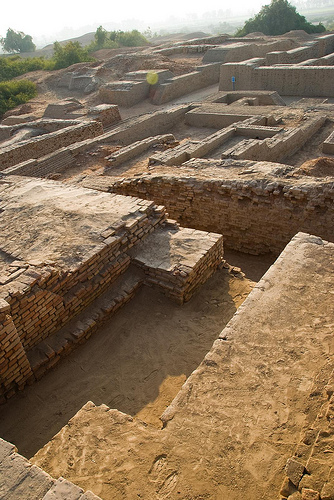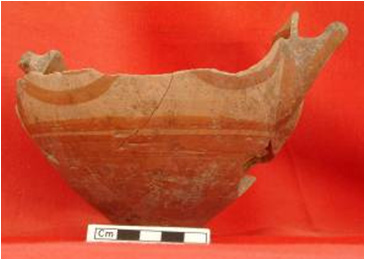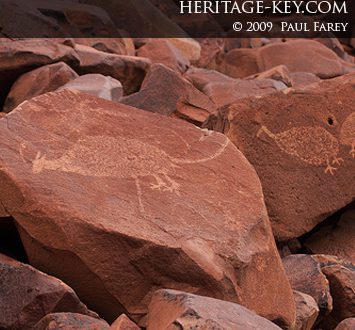For Richard Burger, archaeology has turned up many surprising things. This includes romance, which blossomed when he met his archaeologist wife, Lucy Salazar, at a dig in her native Peru. “Sites are not all that romantic. There’s too much work!” says Burger. Luckily, however, nearby Lima was in the full flood of a Southern Hemisphere Spring, and love found its way out of the dusty remains after all.
But there are other surprises with wider implications for the rest of us in Burger’s work. He’s been digging in Peru for more than 20 years, much of it around the city of Cardal in the Lurin Valley, a one-hour drive east of Lima. Cardal is just one of 9 temple cities that flourished at different times, but somewhat contemporaneously, in a small area on a couple of bends in the Lurin River. These include Mina Perdida and Manchay Bajo. They were all Initial Period cultures – that is, they immediately postdate the invention of fired clay pottery, round about 1,800 BC – and together form what’s known as the “Manchay” culture.
Peaceful Utopian Society
Cardal, it seems, goes back as far as 1,300 BC. Burger’s reconstruction of the society that flourished there for a thousand years shows that they were a remarkably peaceable bunch. “They weren’t in fear of attack. There are no protective walls,” Burger explains of the 9 temple cities up the valley. “All these places are not defensible, and they’re very easy to attack.” This strange phenomenon of not assuming everyone you don’t know wants to bash your head in went on in Peru right up to the time that one of the most spectacular ancient cities – Chavin de Huantar – sprung up in the Northern Peruvian Highlands round about 1,000 BC. “It’s only after that you see the construction of fortresses, moats, parapets, turrets, and all the stuff you’d expect to see,” says Burger. “This is also reflected in the paleopathology of the skeletons. It’s only in later times that you get human skeletal remains with broken bones and cracked heads.”
The violent expansion of local powers is, it seems, inevitable. Burger, who is Professor of Anthropology at Yale University, among a great many other things, has first-hand experience of Peru’s bloody history, as he was driven from his work in the highlands on Chavin by the Sendero Luminoso, who murdered a local judge who was a friend of his. That is how his work on the Lurin Valley got started, in fact. It was safer down in the valley, nearer the coast and the capital. Burger’s work has shown him a fascinating progression in the different civilizations that have sprung up in Peru over the last three or four thousand years.
A Hive of Inter-cultural Activity at Chavin
Chavin, where he started off (and formed the subject of his doctoral thesis) is a high-profile site with lots of sexy stuff, including a gob-smacking temple, built out of white granite and black limestone, neither of which are found locally.
There is also evidence of advanced metallurgical practices, plus a dazzling array of artifacts showing sophisticated artistry in engineering, architecture and decoration. Chavin, it turns out, was the first truly cosmopolitan urban hub in Peru, with a well-developed religious and social structure. It acted as a crossroads for the surrounding, simpler, cultures.
Burger has found obsidian from the high grasslands, pottery from the coast; meat and wool from the surrounding mountains, items from all over. “Chavin center is really a new invention; taking things from the coast and a little from the highlands and the jungle and mixing them all together to create this cosmopolitan urban center, blended into something really distinctive,” Burger explains.
Working there, however, was tough, even before the Sendero Luminosos turned up. At one dig at a village above Chavin, Burger and his fellow archaeologists would have to get up at dawn to beat the local animals to the only source of clean water, before they polluted it. Usually, the spring would have frozen overnight, and they’d have to break the ice to get at the water.
Also there was no food. “We lived on canned tuna and bags of soup,” said Burger. Even in Chavin there were no functioning restaurants and only 2-3 hours of electricity per day, Burger goes on. “If you found someone with an egg to sell, you got lucky.” Archaeologists, he admits, don’t tend to eat well on the job.
Greeks vs. Romans, Manchay style
The Lurin Valley is closer to modern civilization and all its earthly delights, but that’s not what captured Burger’s imagination. At first, archaeologists assumed the Manchay culture developed after the Chavin culture, and so was of limited interest since the sites were considered mere echoes of that civilization. “It’s a bit like not studying the Greeks because you imagine that they’re the result of Roman influence,” Burger laughs. “They’re only just being studied properly now.”
In Lurin, Burger found much to challenge his preconceptions. “I had actually gone into it thinking that these sites would be much more like Chavin, because they had same shape and were so big. So I was very surprised when what we found suggested a much simpler, more egalitarian society. It was also more provincial. At Chavin, you feel you’re at the hub of a network of interactions. But in Lurin, everything seems to come from a few hours walk,” Burger explains. “That really did surprise me.”
Burger was also intrigued by how relatively simple were the artifacts at Cardal, given the sophistication of the architecture. He says this impression was only reinforced by the discovery of very simple burials in the residences at the back of the site. The bodies are buried without much ceremonial stuff, with little decoration.
There is, however, plenty to gawp at in Cardal. The architecture is very beautiful, often covered in painted sculptures. Also, the inhabitants were continually building and rebuilding elements of the city, making them bigger over time. One example is a flight of steps going up the side of a pyramid. At the top, decorating the entrance to a central chamber, is a frieze depicting a giant mouth with three-foot long fangs. This set of steps started as a much smaller enterprise, rebuilt many times, each time bigger, creating a sort of Russian doll effect.
Eerie Find Behind the Pyramid
Burger’s favourite discovery at Cardal, however, was a bizarre religious image that was made out of perishable materials.
It has a gourd body, a head made out of an early form of paper maché, and a top knot made out of blonde rodent and human hair. It has a pierced nose, bracelets and anklets made out of plant fiber, and is dressed in a white cotton cloak. The limbs are articulated and move.
“I’ve never seen anything even remotely like it,” says Burger. “I never imagined finding anything like this. The fact that it survived is nothing short of a miracle. Who knows how many others there were?”
This particular find had been cached on the summit of the main pyramid, just behind where ceremonies were performed. The figure was covered in clay, away from irrigation and where no-one walked, so it was unusually protected.
Unfortunately, this great find is not on display, although it is safe in a museum in Lima “It’s been restored, but they haven’t found the right moment to display it,” explains Burger. “I’m just concerned that it will be displayed in the right environmental and security conditions because I want it to be there the next year. But I’m sure it will get the kind of attention it deserves.”
All in all, Burger has his work cut out for him, as there is a huge area around Cardal and the other Manchay sites in the Lurin Valley still to be explored. “We’re just scratching the surface. There’s so much more to discover,” he sighs. “I feel privileged that I’m able to participate in it.”




